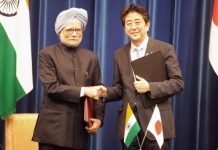When money become skittish
RN Bhaskar
Last week, a Bloomberg newsletter disclosed a very interesting fact. That as many as 107 companies overseas, accounting for a total value of $16.5 billion had been acquired by Indian entrepreneurs. This represented the largest amount of money that Indian entrepreneurs had invested overseas in recent times.
 This number becomes even more important if one considers that the money that fled overseas was larger than the money that was invested in India. This was true for three of the five past years. 2020 and 2023 were the years when inflow was larger than outflow. But when totals are considered, $48.6 billion were invested overseas compared to an inflow of just $38.4 billion.
This number becomes even more important if one considers that the money that fled overseas was larger than the money that was invested in India. This was true for three of the five past years. 2020 and 2023 were the years when inflow was larger than outflow. But when totals are considered, $48.6 billion were invested overseas compared to an inflow of just $38.4 billion.
What this means is that India is losing more money than attracting money.
Great enterprise
From the entrepreneurs’ point of view, this was a great opportunity.
- First, values are depressed in other countries, especially in Europe and even the US, where people have been confronted by a burgeoning debt, low economic growth and a contraction of markets. The two wars – in Europe and the Middle East – have only made economic conditions worse over there (free subscription — https://bhaskarr.substack.com/p/india-china-and-russia-could-be-dancing). So, obviously, there is an opportunity that Indians were keen on capturing.
- Second, thanks to the stock market book, Indian companies could borrow more money from banks – given their high market capitalisation – and buy stocks overseas at lower price-earning multiples.
- Third, they were only too aware of the inevitability of a further depreciation of the Indian rupee. At such times, it makes sense to borrow in dollars, and pay that back later because each dollar sent back will fetch you more rupees.
It was a triple bonanza for Indian businessmen.
Of course, there is always a danger of some trigger-happy policy maker in India banning investments overseas. They are often better at announcing bans than addressing the root causes. But if that happens it will be a double blow of India. First, it will stop investments which could translate into attractive dollar returns in the coming years. Second, it would compel more businessmen to pick up bargain offers using funny money – money that is sent out through unofficial (hawala) channels and registered in some other names. That will weaken the rupee even faster, with disastrous consequences.
Why is the rupee falling?
Economists have been warning the government for long that the policies it was pursuing were going to hurt both industry and the Indian economy. Money was already becoming skittish, and was constantly looking for safer places to park itself.
 The key causes for the rupee falling are actually
The key causes for the rupee falling are actually
- a failure to export more than import, thus worsening the trade balance. Compounding this are
- ideological curbs on leather and beef which are traditionally major export items and employment generators,
- ill-conceived PLI schemes (https://www.youtube.com/watch?v=xcE0Nf6C6wE&t=2s) which favour capital intensive industries requiring constant import of components, and
- an increasingly unhealthy business environment.
The last has caused many wealthy Indians to flee India (https://www.telegraphindia.com/business/35000-high-net-worth-entrepreneurs-left-india-during-narendra-modi-regime-amit-mitra/cid/1835449).
Another cause is the reluctance of Indian policy makers to allow Indian gold in private hands to come out into the open market. This may involve amnesty schemes or other incentives, but will actually allow India to get gold back into the official circulation, which can then be used as collateral for cheaper loans and improve the country’s reserves. Unfortunately, the World Gold Council isn’t really interested in pursuing this measure as it could reduce the demand for imported gold. Do remember that India has unofficial private gold holdings of an estimated 25,000 tonnes. The WGC is after all a body financed by gold producers. They make money when more gold is sold. If India allows its hidden gold to resurface, it could reduce gold imports. Today, a lot of gold continues to be smuggled in (free subscription — https://bhaskarrn.substack.com/p/can-the-inr-slip-further?sd=pf).
High import duties also add to the attractiveness of smuggling. All smuggling invariably causes the rupee to become weaker because dollars are purchased on the black market.
Finally, excessive government spending has caused inflationary pressures. This has two disastrous consequences.
- It makes the poor man lose even the little money he has. Remember, India is a very unequal society. Almost 90% of India’s population earns a per capita national income that is almost half that of sub-Saharan Africa (Free subscription — https://bhaskarr.substack.com/p/did-someone-say-viksit-bharat). If only the government had learnt to be more prudent with spending money.
- Poor management of the economy has led to counterfeit notes proliferating (https://bhaskarr.substack.com/p/demonetisation-is-someone-flying) and an inflation in infrastructure costs (https://bhaskarr.substack.com/p/indias-big-infrastructure-investment) thanks to time and cost overruns.
All this has set into motion forces of deceleration.
GDP has begun tumbling.
So have tax collections. There are good reasons to believe that much of the GST buoyancy was on account of huge government spending on non-productive items like freebies. Each rupee given away as dole or a freebie, invites GST collections when the recipient spends the money. That money further attracts GST, with a cascading effect.
The combination of the above policies has caused GDP to tumble and GST to fall.
 It is only now that the government has realised the extreme folly of overspending and has begun to tighten its purse strings. That is good. But expect the fallout to be harsher on tax collections and GDP. And, yes, the government will be advised to curb the temptation to increase GST rates. Almost 90% of India’s population is already burdened by such taxes. Don’t impoverish them further.
It is only now that the government has realised the extreme folly of overspending and has begun to tighten its purse strings. That is good. But expect the fallout to be harsher on tax collections and GDP. And, yes, the government will be advised to curb the temptation to increase GST rates. Almost 90% of India’s population is already burdened by such taxes. Don’t impoverish them further.
The solution would lie in
- making the business climate friendlier,
- focussing urgently on improving the quality of education so that the youth is employable (https://www.youtube.com/watch?v=m74BaqgWD-g&t=145s), and
- offering more incentives to industry to create production facilities and thus create jobs.
Remember that more jobs will be lost in the next two years, thanks to AI and the march of technology. That will add to the pain youth face. Measures will have to be introduced on a war footing to mitigate this pain, without resorting to freebies. Freebies actually teach people to stop working. That is why the RBI’s largesse to the government was most unfortunate (https://www.youtube.com/watch?v=giY7I71VIJM&t=5s).
Most of all, the government must begin trusting its businessmen, who are after all the people to pay for the perks that ministers and bureaucrats enjoy. They should pay heed to Margaret Thatcher’s exhortation about there being no public money (https://www.youtube.com/watch?v=xvz8tg4MVpA).
India needs to learn its lessons all over again, and usher in liberalisation, and not protectionism with high duties and bans on exports.
Will Indian policymakers learn?
======================
Do watch my latest podcast – a conversation with Manish Chokhani on investments — at https://youtu.be/qplKjVzFf-c
=======================







































COMMENTS